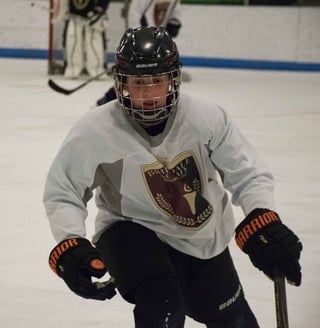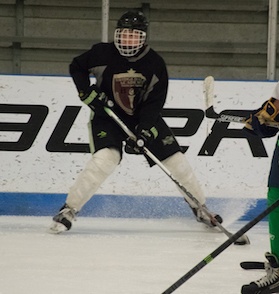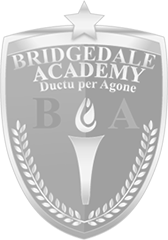What's the Best Way to Train Youth Hockey Players
by Mike McPartlin, Headmaster, Bridgedale Academy
Some questions to ask at the outset in assessing athletic performance
There are nearly as many “theories” about youth hockey development, as there are youth hockey players. And even when a group of players is training at the same camp or clinic and doing the same drills and exercises, in reality the training of each athlete is unique to the individual.
And before getting to which “approach” to training youth hockey players is best for enhancing their athletic performance, it’s important to understand the different things that will impact a player’s individuality. So here are a few questions to ask up front:
What is the developing young hockey player’s body type?
Is he tall? Is he short? Is he thick boned? Is he lean? Is he bow-legged? Or pigeon-toed? Or knock-kneed? Is he lithe and flexible? Is he powerfully built? Are his legs strong enough yet to sustain a deep knee-bend posture so important to a hockey player?
All of these elements will have an impact, and sometimes a dramatic one, on how the player will work his way through the drills and exercises.
 How old is the player chronologically? How old is the player physiologically?
How old is the player chronologically? How old is the player physiologically?
These are two different things, but each will exert a very powerful influence not only on how the player should be training, but also on how the player already is training.
Youth hockey players who are chronologically between the ages of 10 and 15 years old will demonstrate an astonishingly wide range of physiological ages. And this can make a world of difference.
For example, a 12-year old player who is physiologically more like a 10-year old should in fact be training like a 10-year old. In fact, doing so will tend to give him a developmental advantage over the 12-year old who is already physiologically mature like a 14-year old.
However, the player who is “late” physiologically will naturally be under a certain amount of pressure to try to keep up with the other players, including those “early” maturers. And this pressure comes not only from peers, but also from coaches and even parents.
Under present USA Hockey rules governing birth year teams, the late bloomers may have no choice when it comes to competing against players who are physiologically older. But they do have a choice when it comes to how they should be training.
What is the player’s personality type?
Is the player naturally aggressive? Is the player comfortable being assertive when that is called for? Or is the player a more laid back personality type? Or even shy?
The impact of personality type may be most noticeable in battle drills and other such interactive exercises. And of course also in games. But in my opinion it should never be viewed in isolation. It’s important to be aware of the player’s physiological age, as well as other factors, for example his home life, that also exert an influence.
Assertiveness tends to come with maturity, and so even a laid-back personality type can develop great “competitive” instincts when those are nurtured.
Top 3 Approaches
And so, taking into consideration the infinite variations in a player’s body type, physiological age and personality type, are there certain approaches to training youth hockey players that tend to work better than others?
In my experience (which I should probably add is some 40 years of coaching at one level or another, the last 12 years of which was at the AAA level with the Chicago Mission), I’ve identified three approaches that the best hockey coaches I know have tended to use some “version” of.
1. Train the athlete
It is or should be axiomatic, that the best athletes make the best hockey players. The more well-rounded the player is as an athlete, the more likely it is that he will have the agility, balance and coordination to handle physical challenges that come his way. All the best coaches I know adhere to this approach in one way or another.
With respect to the development of a youth hockey player, the earlier that athleticism is incorporated into his “training” the better. And I put the word training in quotes because at the younger ages, much of this development should take place so that it doesn’t feel like training. In other words, youngsters should play other sports, and should be “at play” when they do.
At some point of course, more formal athletic training must be introduced. This is especially true if it is necessary to correct any “inefficiencies” that are hampering athletic performance.
And ultimately, throughout even a professional hockey player’s career, training for athleticism (and not just for hockey skills) will be a constant.
 2. Train for Posture
2. Train for Posture
If there is one single thing that could be identified as the “culprit” that holds back a youth hockey player from developing to his fullest potential, that would be poor posture while skating.
The problem is that having a poor skating posture (which generally corresponds directly to the player’s spine angle) will negatively impact every other aspect of the game. It leads to an inefficient stride, and to inefficient use of the shoulders, arms and hands. And it impacts how a player holds his head, which impacts his in-game vision.
A poor skating posture might itself be related to poor posture generally, meaning that training for proper posture often needs to take place both on-ice and and off-ice.
And as easily identifiable as poor skating posture generally is, it nonetheless doesn’t always get the attention or proper corrective measures it needs. The best coaches, however, will address a player’s posture, and will do so aggressively.
 3. Train for Agility
3. Train for Agility
Over the years I found that training a player for agility (primarily on-ice but also off-ice) has multiple benefits. It is often noted that, along with balance and coordination, agility is one of the ABC’s of athleticism. But training for agility has other more subtle benefits as well.
For example, while training for agility an athlete’s balance and coordination must simultaneously be trained, reinforcing all elements of the ABC’s. Training for agility also develops a player’s explosive leg power, something that helps lengthen the stride for improved speed. Training for agility also enhances a player’s lateral movement and his quickness in changing directions, both valuable skills in hockey.
But most important is the fact that training for agility, both on-ice and off-ice, requires a player to use proper posture. As long as the coach overseeing the training insists on proper execution of the agility drills and exercises, the player will be simultaneously working on his posture. Because a player won’t be able to properly execute an agility drill without proper posture.
In other words, agility requires, and therefore develops, proper posture. And all the top coaches I know understand this, even if only intuitively, and insist upon it with their players during training.
Conclusion:
It is this author's opinion that youth hockey coaches who employ a balanced combination of training that trains the athlete, trains for posture and trains for agility will be very successful at training youth hockey players. As a rule, a dedicated sports academy for hockey will cover all these bases. (See Top 7 Reasons for a Sports Academy.) At Bridgedale Academy, all our student-athletes receive this level of quality training.
Enrollment for the 2020-21 school year at Bridgedale has already begun.






